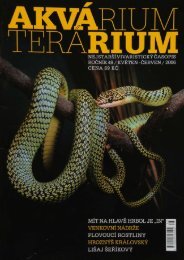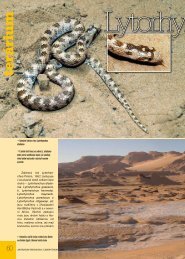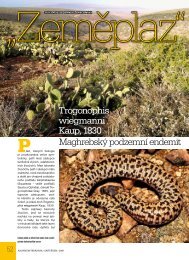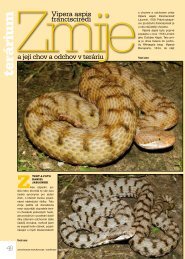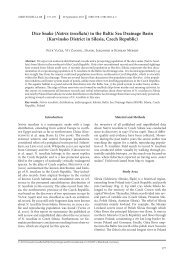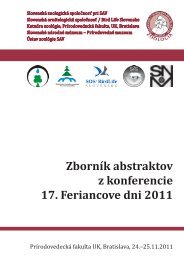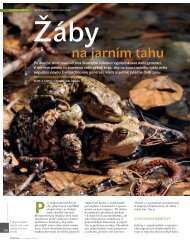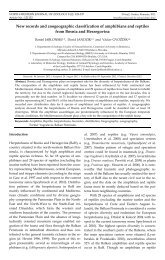Slow worm, Anguis fragilis (Reptilia: Anguidae ... - Daniel Jablonski
Slow worm, Anguis fragilis (Reptilia: Anguidae ... - Daniel Jablonski
Slow worm, Anguis fragilis (Reptilia: Anguidae ... - Daniel Jablonski
You also want an ePaper? Increase the reach of your titles
YUMPU automatically turns print PDFs into web optimized ePapers that Google loves.
V. Gvoždík et al. / Molecular Phylogenetics and Evolution 55 (2010) 460–472 469<br />
A<br />
B<br />
87/85<br />
Pg2<br />
mt clade C<br />
1.00/89<br />
Pg3<br />
Pg1<br />
A. graeca<br />
Bedriaga, 1881<br />
Pg2<br />
54/-<br />
0.76/62<br />
65/64<br />
0.97/63<br />
63/61<br />
0.99/68<br />
Pc2<br />
Pc3<br />
Pc5<br />
mt clade B<br />
A. colchica<br />
(Nordmann, 1840)<br />
Pc5<br />
Pc3<br />
Pc4<br />
Pc2<br />
Pg1<br />
Pg3<br />
90/90<br />
1.00/94<br />
Pc1<br />
63/64<br />
0.97/64<br />
68/63<br />
1.00/67<br />
Pf1<br />
Pc4<br />
Pf3<br />
Pf4<br />
mt clade A<br />
A. <strong>fragilis</strong><br />
Linnaeus, 1758<br />
Pf4<br />
Pf3<br />
Pf2<br />
Pf1<br />
Pc1<br />
Pce1<br />
Pf2<br />
Pce1<br />
A. cephallonica<br />
Werner, 1894<br />
PPaa1<br />
Pseudopus apodus<br />
0.01 substitution/site<br />
Fig. 5. (A) Maximum likelihood phylogram based on phased haplotypes of nuclear PRLR gene. Parameters for the HKY substitution model were as follows: transitions/<br />
transversions ratio = 2.118; base frequencies A = 0.34, C = 0.21, G = 0.23, T = 0.22. Numbers above branches are bootstrap support values for maximum likelihood/maximum<br />
parsimony, and numbers below branches Bayesian posterior probability values/neighbor-joining bootstrap support. Haplotypes sampled from specimens of mitochondrial<br />
clades A–C do not necessarily form corresponding clades in the PRLR pattern, but correspond to the mitochondrial clades A–C as shown in Fig. 2 and Fig. 3. (B) Statistical<br />
parsimony haplotype network of the same data set, PRLR, with circle sizes proportional to haplotype frequencies; small black dots = missing haplotypes. Haplotype names<br />
as listed in Table 1.<br />
name <strong>Anguis</strong> in feminine gender as obvious from his originally<br />
established names like e.g. A. maculata, A. reticulata, etc.; see Article<br />
30.1.4.2 of ICZN (1999)] had for a long time been applied for<br />
the populations from south-eastern Europe and the Caucasus region<br />
(Mertens and Wermuth, 1960). Later the name colchica has<br />
often been applied to the eastern slow <strong>worm</strong> populations including<br />
the northern ones (Arnold, 2002; Dely, 1981). Our findings indeed<br />
confirmed that clade B includes also the Baltic populations<br />
from Lithuania, where the type locality (Vilnius) of <strong>Anguis</strong> incerta<br />
Krynicki, 1837 is located. This name, previously erroneously considered<br />
a junior synonym of A. f. <strong>fragilis</strong> (Mertens and Wermuth,<br />
1960), is older than the name Otophis eryx var. colchica Nordmann,<br />
1840 (=A. f. colchica). However, according to our knowledge,<br />
few authors (e.g. Juszczyk, 1974; Štěpánek, 1949) used<br />
this name after 1899, in contrast to the name A. f. colchica (Nordmann,<br />
1840) which has widely been used in zoological literature<br />
throughout the last century (for references see Supplementary<br />
data). As all authors known to us, who used the name incerta<br />
after 1899, explicitly used this name as infra-subspecific, and<br />
thus invalid according to ICZN (1999) [see articles 45.5 and<br />
45.6], we believe that both conditions of the Article 23.9.1 of<br />
ICZN (1999) [see Supplementary data to discuss the conditions<br />
of the Article 23.9.1.2] have been met to promote the nomenclatural<br />
stability and consider the younger though prevailingly used<br />
name A. colchica (Nordmann, 1840) valid as nomen protectum.<br />
Consequently, we propose to treat A. incerta Krynicki, 1837 as nomen<br />
oblitum.<br />
Regarding the finding that the eastern European populations<br />
north of the Caucasus are geographically separated from the Caucasian<br />
populations (Völkl and Alfermann, 2007) and show distinct<br />
genetic differentiation (Figs. 2 and 3), we propose to treat the east<br />
European populations (subclade B1) as distinct subspecies <strong>Anguis</strong><br />
colchica incerta Krynicki, 1837, restricted type locality (Mertens<br />
and Wermuth, 1960): ‘‘Wilna, Litauen” [=Vilnius, Lithuania] (new<br />
status). The same approach we apply for the similarly divergent<br />
and presumably geographically isolated Caspian populations from<br />
northern Iran and probably from south-eastern Azerbaijan (subclade<br />
B3), for which the subspecific name <strong>Anguis</strong> colchica orientalis<br />
Anderson, 1872 (new status) (type locality: ‘‘Rehst, on the Caspian<br />
Sea” [=Rasht, Iran]) is available.<br />
The species rank of the southern Balkan populations requires<br />
resurrection of the name <strong>Anguis</strong> <strong>fragilis</strong> var. graeca Bedriaga, 1881<br />
(type locality: Parnas Mts., Greece) from the synonymy of A. f.<br />
<strong>fragilis</strong>.<br />
4.3. Distribution and biogeography of the species<br />
The exact distribution pattern of all three species is still little<br />
known. The Common European <strong>Slow</strong> Worm, A. <strong>fragilis</strong> sensu stricto<br />
(s.s.), is distributed from the Iberian Peninsula (confirmed on the<br />
mitochondrial basis) eastwards to Central Europe (Czech Republic,<br />
south-western Slovakia; confirmed by mt and nDNA). The range of<br />
this species presumably continues to Hungary west of the Danube<br />
River (Musters and in den Bosch, 1982), northwards to western



